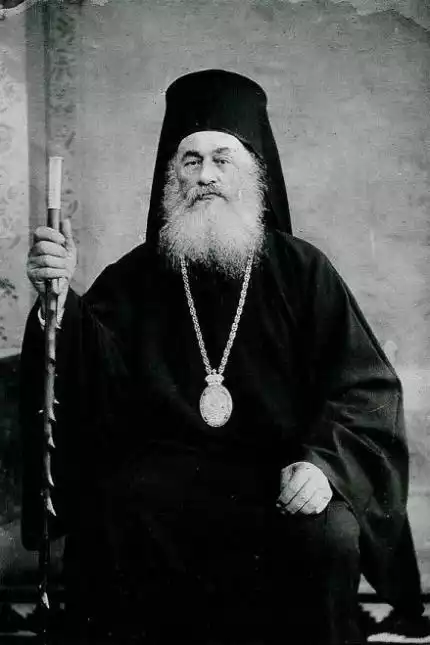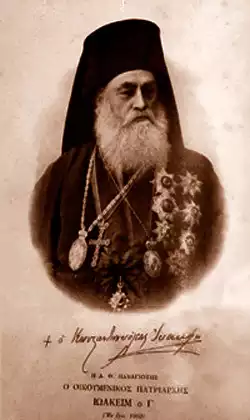
Joachim III the Magnificent (1834-1912), born Christos Dimitriadis or Devezis, remains a revered figure in Orthodox Christianity. His tenure as Ecumenical Patriarch of Constantinople, spanning 1878-1884 and 1901-1912, marked a period of significant ecclesiastical and political developments. His leadership, marked by wisdom and diplomacy, significantly influenced the Orthodox Church and its interactions with various political entities of the time.
Early Life and Clerical Ascent
Birthed on the 30th of January 1834 in Constantinople’s Boyacıköy suburb to parents Dimitrios and Theodora, Joachim III descended maternally from Kroussovo, Pelagonia, and Eastern Thrace. His upbringing, steeped in Orthodox devotion, occurred in the family home.
At age 18 in 1852, Joachim was ordained a deacon, adopting his clerical name. This milestone commenced a ministerial journey distinguished by scholarly diligence and spiritual commitment. Between 1854 and 1860, he performed Greek church duties in Vienna, continuing his studies and acquiring German. Despite lacking formal university schooling, Joachim compensated through open-minded erudition and literary passions.
Shepherded by Metropolitan Joachim II, himself a future Ecumenical Patriarch, Joachim III underwent pivotal clerical and spiritual mentorship. Following Joachim II’s 1863 Patriarchal ascension, Joachim III received priestly ordination and appointment as Great Syncellus, the Patriarch’s foremost assistant. His first major ecclesial post came in 1864 upon election as Metropolitan of Varna, enduring until 1874.
This background illuminates formative experiences that paved Joachim III’s path to leading Orthodoxy. Through scholarly intellect and pious leadership, his hierarchical ascent set the stage for his eventual Patriarchal impact.

Tenure as Ecumenical Patriarch and Legacy
Joachim III’s first tenure as Ecumenical Patriarch commenced in 1878, following the demise of Patriarch Joachim II. His patriarchate was marked by administrative reforms and a deep commitment to education. He founded the Joachimio Parthenagogeion, a significant girls’ school, and revived the Patriarchal Printing Press in 1880. Under his guidance, the periodical “Ekklesiastiki Alitheia” was published, spearheaded by Manouil Gedeon. His efforts also led to the establishment of the Patriarchal Library and the expansion of the Theological School of Halki.
Joachim III’s diplomatic skills shone through his recognition of the autonomy of the Serbian Church in 1879 and the transfer of the Metropolis of Drustra to the Church of Romania. He adeptly handled the integration of Thessaly and Arta’s metropolises into the Church of Greece after their political incorporation. However, his steadfast defense of Orthodox Church privileges led to his coerced resignation in 1884.
After a period of withdrawal and spiritual reflection, including a sojourn at Mount Athos, Joachim III was re-elected as Patriarch in 1901. His second tenure is notable for furthering the Church’s financial and educational agenda, establishing orphanages and a School of Languages and Commerce. His leadership saw the completion of the Baloukli hospitals with substantial diaspora support.
Joachim III’s death on November 13, 1912, marked the end of an era characterized by ecclesiastical growth and diplomatic finesse. He was interred in the patriarchal cemetery at the Baloukli Zoodochos Pigi, shortly after the Greek army’s entry into Thessaloniki.
Joachim III the Magnificent’s legacy as Ecumenical Patriarch is multifaceted, encompassing ecclesiastical governance, educational advancements, and diplomatic engagements. His dual tenures symbolize a bridging of traditional Orthodoxy with the modern world’s demands, epitomizing leadership, wisdom, and adaptability. His impact on the Orthodox Church and its faithful endures to this day.
References
- Fitzgerald, T. “The Orthodox Church”, Penguin Books, 2007.
- Harrington, P. A History of the Eastern Church”, Routledge, 2013.
- Imakb.gr (Accessed January 11, 2024).
- Polignosi.com (Accessed January 11, 2024).
- Google Books (Accessed January 11, 2024).
- Anemi – Digital Library of Modern Greek Studies (Accessed January 11, 2024).
- Meyendorff, J. “Orthodox Church: Its Past and Its Role in the World Today”, St. Vladimir’s Seminary Press, 1996.
